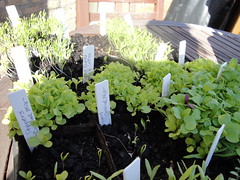 By Michelle Moore
By Michelle Moore
Owner of The Greenhouse Catalog
There is nothing like new life in spring…
…and starting seeds is one of the best ways to enjoy the start of the season.
Unlike transplants, seedlings are fragile and require newborn-like attention:
The right media, temperature, light, water and food.
To a new gardener, meeting these needs may seem like a challenge.
But with a little knowledge and the right equipment, success is easy and just a few short days or weeks away.
With a little knowledge and the right equipment, seed starting success is easy. — Tweet This
Note–before you even start
It is important to select the right seeds. There is nothing wrong with planting seeds that are more than a year old, but if you are trying seed starting for the first time and need a confidence boost—stick to current year seeds for the best germination rate.
What You’ll Need for Seed Starting Success
Media: The best seed-starting media holds moisture and air. Seedlings need to stay moist, but not wet, and need to have plenty of aeration. You can purchase specially formulated seed starting mix, use coco-pith, or a number of seed starting cubes for the best results.
- Related Post: 5 Items You Can Start Your Seeds In
Temperature: Seeds need warmth, so don’t put your seed trays in a drafty area. Add bottom heat for even better and faster roots to development. Seedling heat mats are an excellent investment.
Light: Most seedlings germinate best in light. A sunny window may be enough light, but the addition of a small grow light can make a tremendous difference in a healthy start. Plants receiving too little or too much light tend to get leggy and don’t make for the best transplants. T-5 or LED grow lights are extremely energy efficient and do not take up much space. They also don’t create a lot of heat, so seedlings won’t dry out as quickly.
- Related Post: How to Select the Best Grow Light
Water: Seedlings dry out quickly, so it’s easy to overwater them. The best methods include frequent but gentle misting, or bottom watering. We love the Smart Float tray. It provides an excellent media and the sturdy Styrofoam base floats on the water, so seedlings are never over or under watered. Additionally, the Styrofoam insulates tender seedlings and the white base reflects lights back to plants.
- Greenhouse Catalog Product: Smart Float tray.
Feeding: Once plants have their second set of leaves, they are ready for food (generally within 72 hours of spouting). A high-quality organic fertilizer, diluted to ¼ strength for the first feeding, works well. Continue feeding at ½ strength until seedlings are ready to transplant.
Happy planting and be sure to check all of the seed starting supplies at The Greenhouse Catalog.
About Michelle Moore
Michelle Moore is the owner of the Greenhouse Catalog where she has worked with greenhouses for 20 years. Michelle writes and lectures about greenhouse gardening as an Oregon State University Master Gardener and member of Garden Writers Association. Michelle and her husband live in Oregon, but they enjoy hints of summer all year in their greenhouse! Become a Greenhouse Catalog fan on Facebook to get year-round gardening tips and advice.
Your Turn
Share this post with your friends and family to help them successfully start their seeds this year.
Photo courtesy of janeyhenning on Flickr






















Mike,
Always good information here. I am a big proponent of starting plants from seed instead of buying plants. You have so much more variety available and get healthier plants. This is great advice on getting started.
Tony
Thanks man. For beginners, def easier to start from transplants though.
This article mentioned grow lights; I followed the link but it didn’t really help me. I have a few plants on a balcony that receives no direct sunlight whatsoever, it gets ambient light reflected off surrounding buildings and trees. I put just a regular compact fluorescent bulb in the balcony light, will this help my plants at all?
I don’t think a regular compact fluorescent bulb will work though you may see if it does. The grow light article explains the different kinds of lights, colors and what’s needed for growth.
Started some broccoli seeds and garlic today, I’ll see how they do! PS, I soaked the garlic cloves in the solution from your post on how to grow garlic; fungus is a real problem in the Pacific NW.
Keep me updated.
I purchased 2 very cheap greenhouse flats with the greenhouse plastic lids and the heated seed mats included with the kits. They will not hold up to major use but they will get me by until I can. These have been so much of a blessing for me. With little sun in the late winter/early spring light, and little access to heat, I have been very successful in starting tomatoes and peppers for me. These have been so much of a problem for me to start.
I have heirlooms going now, Stupice, Mortgage Lifters, and some peppers.
My access to light is a small bathroom with a small south window. Between the heat mats, and the sunlight, everything is coming up very well.
For me, these are part of the secret of starting seeds.
Awesome. Thanks for sharing!
This is my second year using the wintersown method. I have never had much success with sowing indoors; they mostly die or I forget to water, etc. But wintersown has given me so much more success; almost everything germinates! Now I need to get success with potatoes in trash cans!
Awesome!
My broccoli seedlings are going crazy! They poked out of the soil yesterday morning and most of them are .5″ – 1″ tall. I used pre-fertilized organic potting soil, do you think I should still feed them after the second leaves show up?
Go for it.
my seedlings get very leggy started indoors and then they die before I can get them outdoors and planted or are too weak for me to want to plant them. Would being near a drafty NE window be causing this or not watering them the right way? I am using a grow light.
Garlic should be planted in fall not now. You plant them outdoors just like you’d plant tulips.